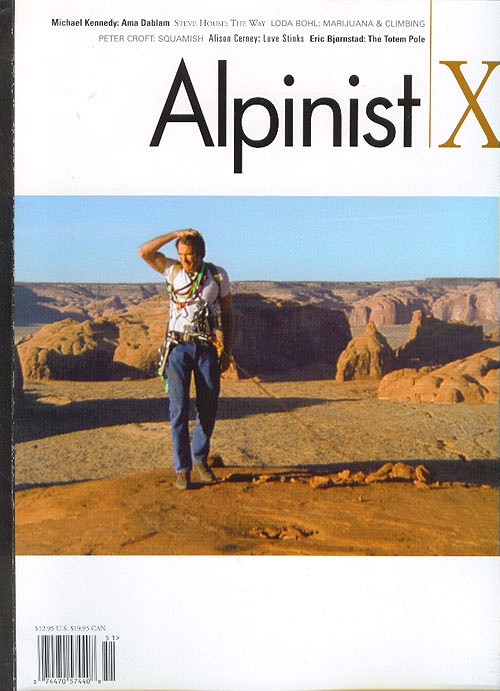
This editorial was first published on Dougald's excellent blog: The Mountain World. Although the internet is full of climbing blogs and sites, Dougald's professional insight in to the climbing media and all aspects of the sport make for a razor sharp commentary and a beacon of inspiration for climbers and climbing pundits worldwide.
You can view Dougald's book Longs Peak at Amazon.com


I just got back from the Utah desert, where the editors of the American Alpine Journal hosted editors of climbing magazines and websites from 11 countries in a six-day International Editors' Summit. We gathered for discussions on the business, content, and ethics of climbing publications in the 21st century. (Plus, of course, some great desert tower and splitter climbing.) During these meetings, we enjoyed the company and wisdom of all three editors of Alpinist: Christian Beckwith, Katie Ives, and online editor Erik Lambert. These are talented folks. Quality folks. And they left our meeting only to learn that their magazine had been shut down. Having had the experience of telling my own magazine staff that they were about to lose their jobs, I know how this whole business feels. It sucks.
The outpouring of emotion over Alpinist's demise is a tribute to the good work these editors did. Readers are offering to do "whatever it takes" to bring Alpinist back. But it's time for a little dose of business reality.
Alpinist was a very good magazine, but it never attracted nearly enough readers to turn a profit, and profit is what keeps all business' doors open. The cyber-space is full of grousing that the "other mags" are fit for little more than butt-wiping, but if the other mags, including the one I sometimes write for (Climbing), are really so bad, then why are they still in business after decades when Alpinist survived less than seven years? Is this because climbers are brain-dead automatons easily seduced by the "mass" media? Is Alpinist the victim of big, bad businesses willing and able to squash the little guy? Give me a break. Both Climbing and Rock & Ice are operated by companies nearly as small as Alpinist, and they're run by hard-core climbers—and without the deep pockets that Alpinist cofounder Marc Ewing was willing to empty now and then to prop up his pet project. Climbing and Rock & Ice survive because they deliver, to greater or lesser extent, what readers and advertisers want to see, with a business model that still works, no matter how damaged and vulnerable to new media it may be. In fact, Climbing's paid, audited circulation has posted substantial gains this year.
Speaking of new media, many climbers ask: Why don't Christian and his fine crew just run Alpinist.com as a stand-alone entity without all the costs of printing and shipping a magazine? Well, it's because producing material as fine as Alpinist's requires paying real journalists and editors decent salaries, and no one has figured out how to make a climbing website generate the kind of revenue to do this, let alone create a real return on investment for owners. As I learned last week at the Editors' Summit, some websites are getting close: UKClimbing.com, for one, supports several salaries without a print publication, and although it is not yet generating a real profit it seems to be the most forward-thinking and innovative of the English-language climbing sites. But UKClimbing is succeeding because of serious investment in technology and talent, and in this economic climate there's not much spare change floating around for risky new investments.
So, what about blogs and other community-supported media? As Peter Beal argues in a post on his Mountains and Water, these new media have changed the publishing landscape for good. No doubt. But most blogs reflect only a tiny sliver of the broader climbing world, and it's nearly impossible for all but the most obsessive online reader to get the full picture by subscribing to blogs. In my job as a climbing news reporter I get paid, in effect, to surf the web, but even so I get overwhelmed by the mostly useless information. Like them or not, the successful climbing magazines perform a valuable service by sifting through all the twitter and latest-greatest and deciding what's worth publishing.
Alpinist or some successor in the same vein may yet survive. My best guess is that someone will buy the excellent Alpinist.com, and another investor might buy the Alpinist Film Fest. But Alpinist the magazine is almost certainly dead, at least in the big, open format that readers loved, and with the talented editorial staff that made it what it was. As beautifully as Alpinist executed the limited-advertising, high-subscription-price, "reader supported" business model, it simply didn't work in the climbing market.
Final note: To those bitching about lost subscription dollars, you're unlikely to see a dime. Even if someone buys Alpinist, you'll get copies of the successor magazine or another publication, not a cash refund. In a bankruptcy settlement, a magazine's printer and other large creditors always come ahead of individual subscribers, and the contributors who wrote stories for the next few planned issues of Alpinist have lost more than you have. Consider your subscription dollars a retroactive donation that helped keep the magazine alive for one or two issues before ultimately succumbing.

Comments